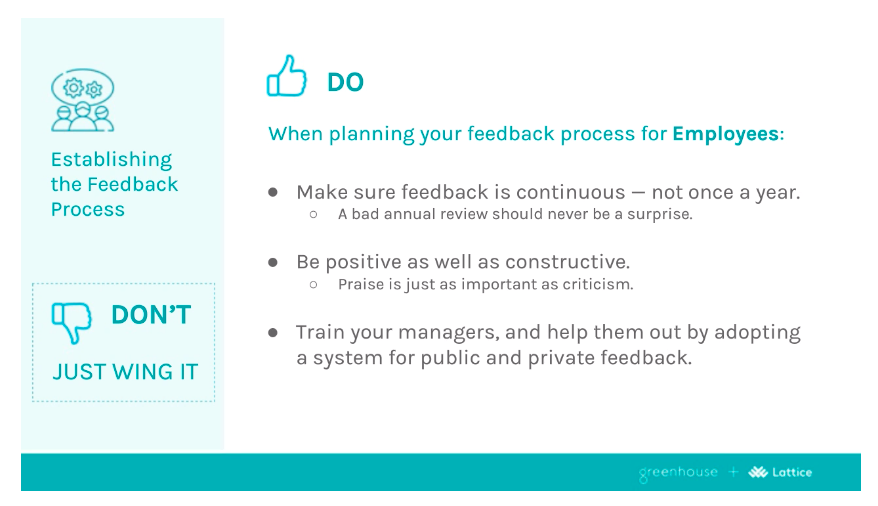The dos and don’ts of delivering feedback to candidates and employees

6 mins, 54 secs read time
Does the mere mention of the word “feedback” make your heart race and your palms sweat? If so, you’re not alone. Opening ourselves up for constructive criticism (or being the ones to offer it) can make even the most confident Talent professional want to crawl under their desk and hide. But feedback doesn’t have to be a daunting concept.
In the recent webinar, “The Dos and Don’ts of Delivering Feedback to Candidates and Employees,” we covered some strategies to help you deliver feedback confidently and competently. Greenhouse’s Recruiting Manager Ariana Moon, Lattice’s Head of Content Marketing Annette Cardwell, and Brooklinen’s VP of People Jaime Petkanics shared their best practices and lessons learned to help you hone your feedback-giving and receiving skills.

We’ll cover a quick recap of some of their insights here, and we’ve also tapped Ariana to answer some questions we weren’t able to address live. Want to watch the entire presentation? Access the on-demand recording here.
Establishing the Feedback Process for Candidates
We did a quick poll of webinar attendees to learn how they currently approach giving feedback to candidates and employees, and the results were eye-opening.
Only 20% of participants said their organization has guidelines or a formal process for giving feedback to both candidates and employees, while 34% said they just do their own thing.
When it comes to feedback for candidates, Greenhouse’s Recruiting Manager Ariana Moon says, “Don’t just wing it. It’s important to be very intentional about your process.”
How can you do this? Here are a few of Ariana’s suggestions:
- Hold your recruiters accountable to being transparent and communicative throughout the hiring process – make sure candidates understand the interview stages, purpose of each discussion, and overall hiring timeline.
- Keep your hiring managers and other interviewers informed, too. Let them know the purpose of the interviews or assessments they’ll be involved with and set expectations for the type of feedback you expect from them.
- Create a scalable approach to giving feedback. At Greenhouse, this means offering to have feedback phone calls for any and every candidate who has participated in the onsite interview.
- Give your recruiting team the chance to practice feedback conversations. Role-playing takes some of the awkwardness and anxiety out of the mix.

Establishing the Feedback Process for Employees
Recruiters aren’t the only ones who can find the feedback process intimidating – managers may also feel unsure about the best way to deliver feedback to direct reports.
“Feedback is a huge part of why Lattice exists. It’s a big part of everything we do here,” says Lattice’s Head of Content Marketing, Annette Cardwell. Here are a few of Annette’s guidelines for establishing a feedback process for employees:
- Giving and receiving feedback isn’t a one-off event. It should be continuous, happening in every one-on-one meeting and every performance review. This helps ensure that a challenging or negative annual review is never a surprise. You want to provide opportunities for employees to course correct throughout the year.
- Feedback should be positive and constructive. Don’t just focus on the negative. And be intentional about offering public praise since it can quickly become part of your company culture.
- Make sure managers are well trained and understand their role in the feedback process. Your goal is to make sure it’s easy for managers to deliver feedback and give them the confidence to know when and how to provide it most effectively.

Post-webinar Exclusive: Recruiting Manager Ariana Moon Answers Audience Questions
Now that we’ve covered how to create a framework for feedback in your company, let’s tackle some of the audience questions that came up during the webinar.
Audience member question: Do you recommend the Radical Candor framework to deliver feedback?
Ariana’s answer: One of the things our VP of People, Cheryl Roubian, says often is that the book Radical Candor by Kim Scott is “equal parts representative and aspirational” of how we think of good management at Greenhouse. I agree, and I try to manifest this idea of caring personally and challenging directly within my own team. With candidates, you don’t have as much time to develop a relationship as you do with employees because you have a limited number of interactions over a given interview process, but nonetheless, I also strive to care personally on candidate feedback calls, because doing so will help me provide the feedback better.
Audience member question: Do you utilize a template for sharing/receiving feedback and use it as a guide for discussion to ensure the conversation stays within the parameters of intent?
Ariana’s answer: I always review the feedback in our internal Greenhouse before delivering my answers. Since we have a structured approach to hiring, the feedback in our scorecards is specific to the technical and interpersonal skills required for each role. This helps ensure that my feedback is relevant to the job they interviewed for.
While I don’t use a template, I always like to start by thanking the candidate for being open to hearing our feedback. Feedback can be hard to hear, and I commend those opting in! I then let the candidate know that they did really well to have made it to the final stages. I also like to admit that as humans, no matter how structured our process, we’re not perfect in our assessment of other people. In the context of interviewing, there’s no way you can assess 100% of someone’s personality or abilities. You spend at most only a few hours with a candidate and then you have to make a judgment call, based on that snapshot.
That’s how I set the stage and then deliver feedback based on what’s in their scorecard in Greenhouse.
Audience member question: How do you avoid getting pushback from candidates?
Ariana’s answer: A lot of recruiters are afraid that candidates will react negatively to feedback, but in my experience, candidates react a lot more positively than negatively. Most are simply grateful because it’s so rare for a recruiter to get on the phone to provide feedback.
That said, I have occasionally received pushback when candidates feel that the feedback they’re hearing from me isn’t accurate. But that’s actually really useful to know as a recruiter.
One time, I had that experience with someone who interviewed for a coordinator role on my team. Our feedback was that we weren’t sure about her motivation to be in the coordinator role. But when I shared this feedback with her over a call, she challenged it and demonstrated that she really did want the role. When the role re-opened a few months later, she was the first person I called – and now she’s on our team! This is a perfect example of how a feedback conversation can actually lead to an amazing outcome.
Audience member question: Are there any features in Greenhouse that promote feedback? We struggle to get our hiring managers to comply with sending feedback to candidates and wanted to see if there were any features/tools we might be missing out on.
Ariana’s answer: Greenhouse (the software) can automatically prompt anyone who conducted an interview to provide their feedback right after the interview is completed, while the experience is fresh. Greenhouse also helps ensure that interviewers can’t see the feedback anyone else has given on the same candidate until they’ve submitted their own. This not only helps reduce groupthink, but also motivates interviewers who are curious to know the outcome of an interview to provide feedback promptly. And finally, if we’re deciding to discuss the feedback on a candidate live, we don’t have the interviewers meet until all the feedback has been submitted. This combination of Greenhouse features and best practices helps ensure we provide feedback in a structured and timely fashion.
Looking for more tips and tricks to help you improve your approach to giving feedback? Be sure to watch the full webinar. You can access the on-demand recording here.
